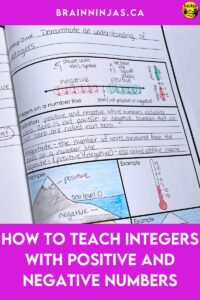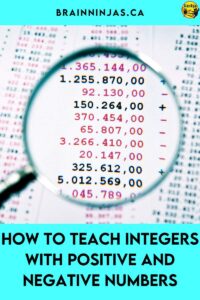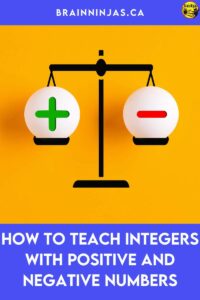
In upper elementary, we’re asked to teach positive and negative numbers. This is when we start to refer to numbers as integers, which means reframing math vocabulary for our students. Come learn how we teach integers in our upper elementary math class.
Defining and Teaching Integers
An integer is a mathematical concept used to represent whole numbers. This includes both positive and negative and zero. To be clear, fractions and decimals are not integers because they are not whole numbers. Integers are used in various mathematical operations, including addition, subtraction, multiplication, and division.
Positive numbers are integers greater than zero. They represent quantities, values, or magnitudes greater than nothing. For example, 1, 2, 3, 100, and so on are all positive integers. Positive numbers are often used for gains, profits, or quantities of items. We point out that up until this point, all the numbers they’ve worked with are positive and we’ve been lazy by not writing the + symbol in front.
Negative numbers, on the other hand, are integers less than zero. They represent quantities, values, or magnitudes less than nothing. For example, -1, -2, -3, -100, and so on are all negative integers. Negative numbers are often used for losses, debts, or decreases in quantities.
In terms of a number line, positive numbers are located to the right of zero, while negative numbers are located to the left of zero. Zero itself is neither positive nor negative; it serves as the starting point on the number line.
Using Our Math Units to Teach Integers
Our lessons about integers are part of our Interactive Math Units. These units include lesson plans, background information for the teacher, student practice pages, activities and assessments, so you’ll have everything you need to teach, review and assess without all the planning.
Find the Numbers and Integers Interactive Math Unit for Grade 5/6 (designed for combined grade level classes) is available on TpT ($USD) or our BN Shop ($CAN).
Numbers and Integers Interactive Math Unit for Grade 6 is available on TpT ($USD) or our BN Shop ($CAN).
What is an Additive Inverse?

We’ll be honest and say when the new Alberta math curriculum came out we found ourselves searching for a lot of definitions, but it’s just a fancy way of saying, a number’s opposite.
The additive inverse is also known as the opposite or negation. If you have a positive integer +n, its additive inverse is the negative integer with the same magnitude (so it would -n). Conversely, if you have a negative integer −n, its additive inverse is the positive integer with the same magnitude (so it would be +n).
Teach the Rules for Operations With Integers
Teach students the rules and formulas for adding, subtracting, multiplying, and dividing positive and negative numbers. Provide mnemonic devices or visual aids to help students remember these rules, such as the “Same Sign Add and Keep, Different Sign Subtract and Take” mnemonic for adding and subtracting integers.
When performing mathematical operations involving positive and negative numbers, certain rules apply:
- Adding a positive number to another positive number results in a positive number.
- Adding a negative number to another negative number results in a negative number.
- Subtracting a positive number from another positive number results in a positive number.
- Adding a positive number to a negative number results in either a positive or negative number, depending on their magnitudes.
- Subtracting a negative number from another negative number results in a positive number.
- Subtracting a negative number from a positive number results in either a positive or negative number, depending on their magnitudes.
These rules make a great anchor chart (just saying).
Videos
PBS Learning Media has some great videos on this page, with the caveat that the thermometers are clearly in Fahrenheit (because if it’s +70 where you are in Celsius, seek help).
Anywhere Math on YouTube has a pretty good video to reinforce learning. Lots of vocabulary is included with good explanations. It also has some graphing on a number line and story problems as examples.
Mathantics has an introduction to negative numbers. They also have this great video on YouTube about adding and subtracting integers. They also have one for multiplying and dividing integers.
Khan Academy has a whole course about negative numbers with videos and materials to practice (for free) found here.
Ways to Practice Working With Integers

Number Line Walk
Use a large number line on the floor and have students physically walk along it to demonstrate positive and negative movements. Create a large number line on the classroom floor or wall, extending in both directions. Use colored tape or markers to distinguish between positive and negative numbers. This kinesthetic activity helps them visualize the concept.
Temperature Changes
Relate positive and negative numbers to temperature. Discuss scenarios where the temperature goes above and below zero. Students can create temperature scenarios and represent them using positive and negative numbers. Have students interpret temperature changes in real-world scenarios, such as weather forecasts or changes in indoor temperatures.
Bank Account Simulation
Give students a virtual amount of money (positive number) and introduce expenses or debts (negative numbers). Simulate scenarios where students borrow money (negative numbers) and receive payments (positive numbers). Have them keep track of their balance, reinforcing the idea of positive and negative integers in real-life situations.
Worksheets
Our worksheet sets do not include lessons, but some pages have illustrated examples. We use worksheets to practice, review and even assess. If you’re looking to take worksheets to the next level by turning them into engaging games, check out our post Math Worksheet Games Your Students Will Love.
- Introducing Integers is available on TpT ($USD) or our BN Shop ($CAN).
- Comparing and Ordering Integers is available on TpT ($USD) or our BN Shop ($CAN).
- Add and Subtract Integers can be found on TpT ($USD) or our BN Shop ($CAN).
Keeping Score
Virtually any game where points are awarded and taken away can be turned into an opportunity to add and subtract integers.
We created this game that can be used with any set of task cards. When students get the question correct they earn (or lose) points for their team. You can find Whamu! (It’s pronounced Wham-You) in our Resource Library. We can send it directly to your inbox when you sign up for our email list.
Elevator Ride
Imagine an elevator starting at the ground floor (0). Going up represents positive numbers, and going down represents negative numbers. Create story problems where students need to calculate the floor number after the elevator moves. Better yet, have students make up the word problems.
Integer Chips

Provide students with integer chips or counters, with one color representing positive numbers and another color representing negative numbers. We use foam two-colour counters for this and just write numbers directly on them (without the symbols in front of the numbers. All the red side is negative and the yellow is positive. Students grab a handful and then drop them and have to add up the value.
You can also use these manipulatives to model addition, subtraction, and comparison of positive and negative numbers.
Use algebra tiles. Algebra tiles or blocks visually represent positive and negative numbers and operations. Students can model addition, subtraction, and multiplication of positive and negative numbers by combining or canceling out tiles.
Number Line Battleship
Adapt the classic Battleship game by using a number line. Students will need to know the first two quadrants of the Cartesian plane. Each grid space represents a specific number, positive or negative. Students use coordinates to guess opponents’ hidden integers, reinforcing their understanding of positive and negative values.
Board Games
Use board games like Monopoly or create custom board games where students perform operations with positive and negative numbers. Landing on certain spaces might require adding, subtracting, multiplying, or dividing integers. Any game where money is collected and spent will work, too.
Peer Teaching and Explaining
Have students explain positive and negative number concepts to their peers. Teaching others reinforces their understanding and helps them clarify their own knowledge.
Students could create an anchor chart for the classroom. If you don’t have room to hang them, take photos and print the photos. Place the photos in your math notebooks. The process of creating the chart will show you what students know (or don’t know).
Integer War Card Game

Adapt the traditional card game of War to practice comparing positive and negative numbers. Assign positive values to cards from one suit and negative values to cards from another suit. Students compare the values of their cards to determine the winner of each round.
Number Balance
Introduce students to a number balance or pan balance to explore the concept of equality with positive and negative numbers. Students can experiment with adding and subtracting weights on both sides of the balance to maintain equilibrium.
Do You Teach Math?
You might find some of our other math posts helpful.
- How to Unfold Geometry: Books to Shape Your Unit
- How to Help Your Students Master Decimal Operations
- 7 Ways to Upgrade Your Fraction Strategies
- How to Demystify Math With These 7 Algebra Activities
- How to Teach Rounding Numbers
- Conquer Math With These Proven Multiplication Strategies
- How to Make Teaching Patterns Painless
- Amazing Measurement Activities to Stretch Math
- How to Teach Students to Tell Time
- Ways to Teach Classifying Triangles
- How to Teach Successful Long Division Strategies
- Ways to Bring Graphing Activities into Your Classroom Daily
- Mastering the Angles: Innovative Approaches to Teaching Geometry Concepts
What Else Do You Do?
Teaching students about positive and negative numbers can be engaging and interactive with the right combination of activities. What did we miss? Do you have other strategies that work for your students? We’d love you to tell us about them in the comments below.







